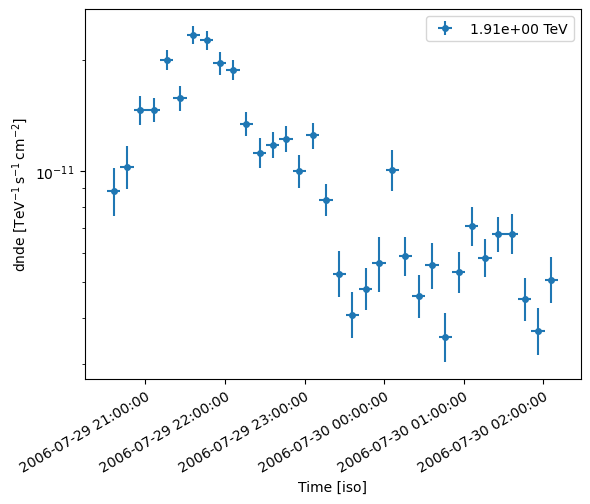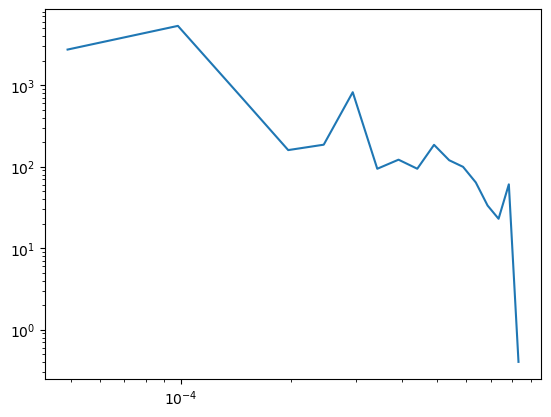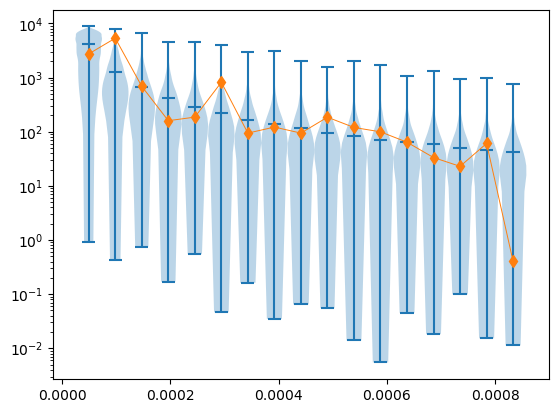This is a fixed-text formatted version of a Jupyter notebook
Source files: fit-psd-lightcurve.ipynb | fit-psd-lightcurve.py
Environment: env.yml
Generating synthetic lightcurves and fitting the power spectral density of a lightcurve
This notebook presents the advanced Emmanoulopoulos algorithm for the simulation of synthetic lightcurves. The original paper describing the algorithm is linked here. The version implemented here is compatible with the Gammapy implementation of the Timmer-Koenig algorithm. The Timmer-Koenig algorithm generates synthetic lightcurve from a chosen power spectral density (PSD) shape. However, it can only generate time series with a gaussian probability density function (PDF). This is adequate for high-statistics astrophysical domains such as the optical or X-rays, but can be in issue when trying to reproduce curves in the gamma-ray domain, where photon counts are lower and statistics are generally Poissonian. The Emmanoulopoulos algorithm tries to solve this issue, combining a requested PSD and PDF in the simulation. It provides accurate synthetic lightcurves in a range of spectral indexes between -1 and -2 for power-law or similar PSDs.
Together with the simulation algorithm the notebook shows a function to compute the PSD envelope for a lightcurve using either the Timmer-Koenig or the Emmanoulopoulos algorithm. This envelope is then used to fit the PSD fot he observed lightcurve, by passing through a tailored chi-squared-like cost function. This complex fitting is necessary to account for the fact that the periodogram of the observed lightcurve is only a possible realization of the PSD model, moreover convoluted with Poissonian noise and instrumental responses. This can lead to biases or deformation due to random fluctuation of the realization if extracted with a simple curve fit of the periodogram.
The results are satisfactory for power-law or broken-power-law PSDs in a physical interval of spectral indexes, between -1 and -2. Using the Emmanoulopoulos algorithm shows consistently better PSD reconstruction over the Timmer-Koenig - this is due to the injected non-gaussian PDF.
The functions for the Timmer-Koenig and Emmanoulopoulos algorithms, the envelope, x2-like cost function for fitting, and some helper analytical functions are implemented in the helper package gammapy_SyLC.
Imports
The first step is importing some usual packages, needed Astropy utilities, scipy tools for PDFs and minimization, and Gammapy functions and classes for the observational part.
[1]:
import gammapy
print(f"Gammapy version : {gammapy.__version__}")
Gammapy version : 1.2
[2]:
import numpy as np
from pathlib import Path
import matplotlib.pyplot as plt
import inspect
import astropy.units as u
from astropy.coordinates import SkyCoord, AltAz
from regions import PointSkyRegion
from gammapy.estimators import LightCurveEstimator, FluxPoints
from gammapy.makers import SpectrumDatasetMaker
from gammapy.data import Observation, observatory_locations, FixedPointingInfo
from gammapy.datasets import Datasets, SpectrumDataset
from gammapy.irf import load_irf_dict_from_file
from gammapy.maps import MapAxis, RegionGeom, TimeMapAxis, RegionNDMap
from gammapy.modeling.models import (
SkyModel,
PowerLawSpectralModel,
LightCurveTemplateTemporalModel,
)
from gammapy.estimators.utils import compute_lightcurve_fvar
from gammapy.utils.random import get_random_state
from scipy.optimize import minimize
from scipy.signal import periodogram
from scipy.stats import lognorm
Additionally, we import the necessary functions for lightcurve simulation and fitting from the helper package gammapy_SyLC. The package can be obtained from github and installed by running:
git clone https://github.com/cgalelli/gammapy_SyLC.gitcd gammapy_SyLCpython -m pip install -e .[3]:
from gammapy_SyLC import (
TimmerKonig_lightcurve_simulator,
Emmanoulopoulos_lightcurve_simulator,
lightcurve_psd_envelope,
x2_fit,
pl,
)
Reference Lightcurve
As a reference, the notebook uses the H.E.S.S. dataset for the PKS2155 AGN flare of 2006. Data properties such as mean and standard deviation fo the norm, number of points, sampling frequency, are taken from this flare. The synthetic lightcurve will be oversampled by a factor 10.
[4]:
lc_path = Path("$GAMMAPY_DATA/estimators/")
lc_filename = "pks2155_hess_lc/pks2155_hess_lc.fits"
lc = FluxPoints.read(lc_path / lc_filename, format="lightcurve")
odata = lc.norm.data.flatten()
omean = odata.mean()
ostd = odata.std()
npoints = len(lc.norm.data) * 10
times = lc.geom.axes["time"].edges
tref = lc.geom.axes["time"].reference_time
smax = np.diff(times).max() / 10
lc.plot()
plt.show()

Simulation
As a first step, the parameters for the functions used as models in the simulations are setup here:
[5]:
ln_params = {"s": 0.5, "loc": 1.5, "scale": 1}
pl_params = {"index": -1.4}
Both the TK and EMM algorithms are called with the same power-law PSD. The EMM algorithm uses a lognormal PDF. The difference between TK and EMM algorithms is shown in the leftmost and rightmost plot, where the gaussian vs lognormal shape is evident. The middle plot shows the perfect compatibility in the periodogram. Seed is fixed for reproducibility.
[6]:
%%time
seed = 532019
# seed = "random-seed"
lctk2, taxis2 = Emmanoulopoulos_lightcurve_simulator(
lognorm.pdf,
pl,
npoints,
smax,
pdf_params=ln_params,
psd_params=pl_params,
mean=omean,
std=ostd,
random_state=seed,
)
lctk, taxis = TimmerKonig_lightcurve_simulator(
pl,
npoints,
smax,
power_spectrum_params=pl_params,
mean=omean,
std=ostd,
random_state=seed,
)
freqstk, pgramtk = periodogram(lctk, 1 / smax.value)
freqstk2, pgramtk2 = periodogram(lctk2, 1 / smax.value)
fig, (ax1, ax2, ax3) = plt.subplots(1, 3, figsize=(15, 3))
ax1.plot(taxis, lctk)
ax2.loglog(freqstk[1:], pgramtk[1:])
ax3.hist(lctk)
ax1.plot(taxis2, lctk2)
ax2.loglog(freqstk2[1:], pgramtk2[1:])
ax3.hist(lctk2)
coeff = np.polyfit(np.log(freqstk[1:]), np.log(pgramtk[1:]), 1)
coeff2 = np.polyfit(np.log(freqstk2[1:]), np.log(pgramtk2[1:]), 1)
print(coeff, coeff2)
[-1.47301407 -7.35992191] [-1.41604412 -6.92936994]
CPU times: user 105 ms, sys: 8.16 ms, total: 113 ms
Wall time: 113 ms

Gammapy setup and simulation
Setup of geometry for the Gammapy simulation. Generic setup for pointing, energy binning, and IRFs. For realistic simulations, choose IRFs that are consistent with the instrument and observational conditions.
[7]:
TimeMapAxis.time_format = "iso"
path = Path("$GAMMAPY_DATA/cta-caldb")
irf_filename = "Prod5-South-20deg-AverageAz-14MSTs37SSTs.180000s-v0.1.fits.gz"
irfs = load_irf_dict_from_file(path / irf_filename)
energy_axis = MapAxis.from_energy_bounds(
energy_min=0.1 * u.TeV, energy_max=100 * u.TeV, nbin=1
)
energy_axis_true = MapAxis.from_edges(
np.logspace(-1.2, 2.0, 31), unit="TeV", name="energy_true", interp="log"
)
time_axis = MapAxis.from_nodes(taxis, name="time", interp="lin")
geom = RegionGeom.create(
"galactic;circle(107.65, -40.17, 5)", axes=[energy_axis]
)
pointing_position = SkyCoord(107.65, -40.17, unit="deg", frame="galactic")
pointing = FixedPointingInfo(
fixed_icrs=SkyCoord(107.65, -40.17, unit="deg", frame="galactic").icrs,
)
The time series generated via EMM is taken as a LightCurveTemplateTemporalModel
[8]:
gti_t0 = tref
spectral_model = PowerLawSpectralModel(
amplitude=1e-10 * u.TeV**-1 * u.cm**-2 * u.s**-1
)
m = RegionNDMap.create(
region=PointSkyRegion(center=pointing_position),
axes=[time_axis],
unit="cm-2s-1TeV-1",
)
m.quantity = lctk2
temporal_model = LightCurveTemplateTemporalModel(m, t_ref=gti_t0)
model_simu = SkyModel(
spectral_model=spectral_model,
temporal_model=temporal_model,
name="model-simu",
)
Observation timing setup and simulation fo the datasets. The “observational” sampling is taken to be much sparser than the synthetic lightcurve, to avoid aliasing.
[9]:
lvtm = 10 * u.min
tstart = gti_t0 + np.arange(npoints / 10) * lvtm
altaz = pointing_position.transform_to(
AltAz(obstime=tstart, location=observatory_locations["cta_south"])
)
[10]:
datasets = Datasets()
empty = SpectrumDataset.create(
geom=geom, energy_axis_true=energy_axis_true, name="empty"
)
maker = SpectrumDatasetMaker(selection=["exposure", "background", "edisp"])
for idx in range(len(tstart)):
obs = Observation.create(
pointing=pointing,
livetime=lvtm,
tstart=tstart[idx],
irfs=irfs,
reference_time=gti_t0,
obs_id=idx,
location=observatory_locations["cta_south"],
)
empty_i = empty.copy(name=f"dataset-{idx}")
dataset = maker.run(empty_i, obs)
dataset.models = model_simu
dataset.fake()
datasets.append(dataset)
spectral_model = PowerLawSpectralModel(
amplitude=7e-11 * u.TeV**-1 * u.cm**-2 * u.s**-1
)
model_fit = SkyModel(spectral_model=spectral_model, name="model-fit")
datasets.models = model_fit
Lightcurve estimator setup and run.
[11]:
lc_maker_1d = LightCurveEstimator(
energy_edges=[0.1, 100] * u.TeV,
source="model-fit",
selection_optional=["ul"],
)
lc_1d = lc_maker_1d.run(datasets)
lc_1d.plot();

Assessment of the properties of the “observed” lightcurve in the time and frequency domain.
[12]:
data = lc_1d.norm.data.flatten()
dmean = data.mean()
dstd = data.std()
dnpoints = len(data)
dtimes = lc_1d.geom.axes["time"].edges
dsmax = np.diff(dtimes).max()
ffreqs, pgram = periodogram(data, 1 / dsmax.value)
coeff = np.polyfit(np.log(ffreqs[1:]), np.log(pgram[1:]), 1)
print(coeff[0])
plt.loglog(ffreqs[1:], pgram[1:])
-2.0837448779604903
[12]:
[<matplotlib.lines.Line2D at 0x7f1f01554610>]

Fitting
The x2_fit function is used as a cost function with the scipy minimizer, providing a fit of the spectral index for the “observed” lightcurve assuming a power-law PSD.
[13]:
%%time
initial_pars = [-2]
results = minimize(
x2_fit,
initial_pars,
args=(
pgram[1:],
dnpoints,
dsmax,
pl,
lognorm.pdf,
ln_params,
"EMM",
10000,
dmean,
dstd,
False,
),
method="Powell",
options={"disp": True},
)
print(results)
envelopes, freqs = lightcurve_psd_envelope(
pl,
dnpoints,
dsmax,
psd_params={"index": results.x},
simulator="EMM",
pdf=lognorm.pdf,
pdf_params=ln_params,
nsims=10000,
mean=dmean,
std=dstd,
poisson=False,
)
plt.violinplot(envelopes, freqs, widths=np.diff(freqs).min(), showmedians=True)
plt.plot(freqs, pgram[1:], linewidth=0.7, marker="d")
plt.yscale("log")
plt.show()
Optimization terminated successfully.
Current function value: 0.592600
Iterations: 2
Function evaluations: 34
message: Optimization terminated successfully.
success: True
status: 0
fun: 0.5926
x: [-1.579e+00]
nit: 2
direc: [[ 1.000e+00]]
nfev: 34

CPU times: user 24min 21s, sys: 2.25 s, total: 24min 24s
Wall time: 24min 24s
Recipe by Claudio Galelli